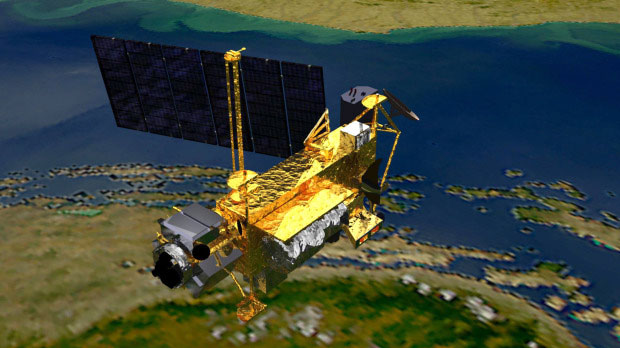 WASHINGTON, Sept 24) – The biggest piece of US space junk to fall in 30 years is hurtling towards a vast span of territory that includes Canada and Africa as well as plenty of open ocean, NASA said Friday.
WASHINGTON, Sept 24) – The biggest piece of US space junk to fall in 30 years is hurtling towards a vast span of territory that includes Canada and Africa as well as plenty of open ocean, NASA said Friday.
The US space agency stressed there was a “very remote” risk to the public from the 26 fragments of the Upper Atmosphere Research Satellite (UARS) expected to survive the fiery re-entry into the atmosphere.
The latest data showed the debris was expected to re-enter Earth’s atmosphere between 11:45 pm Friday and 12:45 am Saturday (0345-0445 GMT Saturday), according to NASA’s latest update.
“During that time period, the satellite will be passing over Canada and Africa, as well as vast areas of the Pacific, Atlantic and Indian oceans. The risk to public safety is very remote,” the agency added.
Earlier updates had mentioned Australia as a possible site for touchdown of the space junk.
The Center for Orbital and Reentry Debris Studies at the California-based Aerospace Corporation predicted the re-entry would occur at 0404 GMT Saturday, plus or minus three hours.
The two dozen parts that survive the re-entry may weigh as little as two pounds (one kilogram) or as much as 350 pounds (158 kilograms), NASA said, and the debris field is expected to span 500 miles (800 kilometers).
The tumbling motion of the satellite has made it difficult to narrow down the location. And given that the world is 70 percent water, an ocean landing was considered likely.
“In the entire 50 plus year history of the space program, no person has ever been injured by a piece of re-entering space debris,” said Mark Matney, an orbital debris scientist at NASA.
“Keep in mind we have bits of debris re-entering the atmosphere every single day.”
The US Department of Defense and NASA were busy tracking the debris and keeping all federal disaster agencies informed, a NASA spokeswoman said.
The Federal Aviation Administration issued a notice Thursday to pilots and flight crews of the potential hazard, and urged them to report any falling space debris and take note of its position and time.
Early Friday, Italy’s civil protection agency warned that the probability of a crash in its northern territory had risen from 0.6 to 1.5 percent, and urged residents to stay indoors, on lower floors, preferably near load bearing walls.
Orbital debris experts say space junk of this size from broken-down satellites and spent rockets tends to fall back to Earth about once a year, though this is the biggest NASA satellite to fall in three decades.
NASA’s 85-ton Skylab crashed into western Australia in 1979.
The surviving chunks of the tour-bus-sized UARS, which launched in 1991 and was decommissioned in 2005, will likely include titanium fuel tanks, beryllium housing and stainless steel batteries and wheel rims.
“No consideration ever was given to shooting it down,” NASA spokeswoman Beth Dickey said.
The craft contains no fuel and so is not expected to explode on impact, and NASA also said on Twitter that talk of “flaming space debris” was a “myth.”
“Pieces of UARS landing on Earth will not be very hot. Heating stops 20 miles up, cools after that,” NASA said, adding that UARS contains nothing radioactive but its metal fragments could be sharp.
The US space agency has warned anyone who comes across what they believe may be UARS debris not to touch it but to contact authorities for assistance.
Space law professor Frans von der Dunk from the University of Nebraska-Lincoln told AFP that the United States will likely have to pay damages to any country where the debris falls.
“The damage to be compensated is essentially without limit,” von der Dunk said, referring to the 1972 Liability Convention to which the United States is one of 80 state signatories.









































